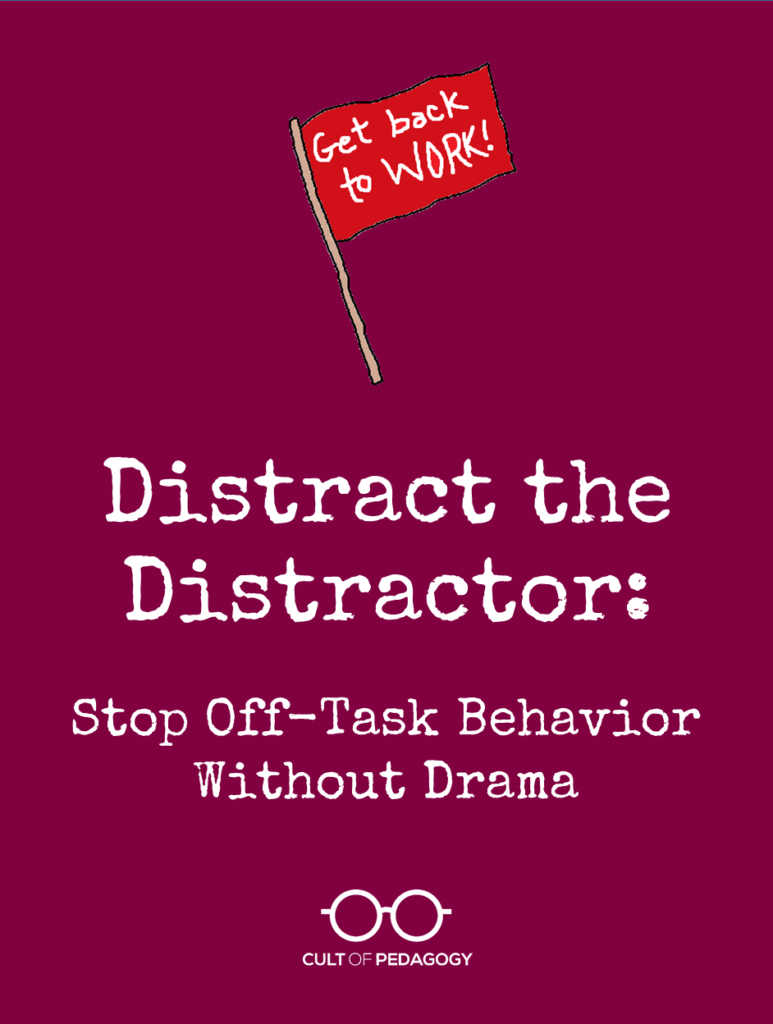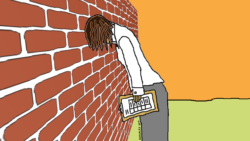
Lots of monster-sized discipline problems start with a single off-task behavior. If you put a damper on those little behaviors, you’ll keep a lot of big ones away, too.
It starts so simply: Instead of doing his silent reading, a boy at table 3 leans over and whispers to the kid next to him. At a training session, two participants scroll through their phones instead of listening to you. During soccer practice, one of the girls you coach starts bouncing the ball off her butt.
These small, off-task behaviors happen all the time. Depending on how you handle them, they could either go away or escalate into a full-scale blowup. In this video, I’ll describe a small but powerful classroom management technique called “Distract the Distractor,” where instead of calling attention to the off-task behavior, you re-engage the student with a content-based question:
Not all discipline problems can be prevented with this technique; some students arrive in a mood that will not be diffused, no matter what. And there’s no substitute for the tried-and-true combination of engaging lessons and good student-teacher relationships. But even in the best of circumstances, kids and adults alike can get distracted. This method is a good addition to your bag of tricks, something that can de-stress your teaching environment and give you and your students more time for learning. ♦
[Note: The name “Distract the Distractor” comes from the book Opportunities and Options in Classroom Management (Pearson, 2003), by Patricia Kyle and Lawrence Rogien.]
If you found this post useful, I’d love to have you come back for more. Join my mailing list and get weekly tips, tools, and inspiration — in quick, bite-sized packages — all geared toward making your teaching more effective and joyful. To thank you, I’ll send you a free copy of my new e-booklet, 20 Ways to Cut Your Grading Time in Half. I look forward to getting to know you better!





I can’t figure out why my silence doesn’t work. It catches about half or two-thirds of the kids’ attention, but I have to wait way too long for the other kids to figure it out, and then the conversations fizzle out over the course of a minute or so. It’s becoming a huge waste of time, and other methods aren’t really working.
I will try distract the distractor, during instruction but what about while I’m giving directions or introducing a topic, something you can’t really expect them to know answers to?
Hi! Man, that is so frustrating. I’m not sure if you’ve seen my two posts on using notebooks along with silence to quiet your class — that might be what you’re referring to, or maybe you’ve just tried silence alone and haven’t had a lot of success. If you haven’t added the notebook aspect, see if that works.
It also helps to add some kind of hand gesture to the wait time, some kind of signal to let them know you need their attention. I found that just holding my hand up (almost like I was stopping traffic) would definitely speed things up. If you are teaching young kids (grades K-3) something like a Whole Brain Teaching’s Class-Yes is ideal (and Whole Brain Teaching is actually great for older kids, too).
Finally, it’s important to have consequences. Talk to your class ahead of time and let them know that if you can’t get their attention after a few basic attempts, you’re going to start recording the names of students who take too long to respond. This can be done in a notebook (as I describe in Notebooks for Classroom Management, Part 2) or on the board, if your school allows this. Once a student’s name has been written several times for the same problem, there will be a consequence — this can be something like being last to leave class, having to eat lunch separate from their classmates, or writing sentences — believe it or not, this is what my own students suggested as a consequence for excessive talking! Let me know what you try and how it works, and we’ll work together on this until you get it down pat. Good luck!
Hi! I’m a brand new digital media teacher, and my class involves a lot of individual work time where students are working on their own on projects. The problem is that there’s not a daily lecture or worksheets I could ask content-based questions on. It’s a project based learning school and I’m having trouble figuring out how to incorporate this technique. I am really struggling to corral the behavior of several seniors who are all friends in my class and constantly talk and bring the volume to ridiculous levels. I’ve created a seating chart to separate them but somehow they end up at the same table or talking from across the room. The problem is that the school has me teaching three classes at once; three different sections of my class exist in the same room at the same time; a beginning, intermediate, and advanced. So often times I have to work with one group while leaving the other group relatively unsupervised in my classroom. It’s those times when they get the most rowdy, when I’m not standing directly over them to supervise. Is it just unreasonable to think I could maintain control of over 30 students in separate sections, or is there some strategy I could use?
I give students an assignment that is due at the end of a period. This helps students to keep on task. At this point, I have three choices if the assignment is too long. 1. Collect it and grade appropriately… 2. Tell students because they have been on task, the assignment will be extended as a homework. 3. Tell students because they have been on task, the assignment will be extended to the next class period. This works particularly well if the assignment was originally intended to be a multiple class period assignment. Students feel they are rewarded for being on task and allows for review at the beginning of the next class period.
This is such great advice. I’ve been struggling with distractors and I plan to implement your method this week!! Thanks very much!!
Thanks Jennifer. Where I am based that approach is called “Redirect to the Learning”, a title which is a very effective descriptor as well. It works because it doesn’t engage the student in a power battle and, as you explain, doesn’t belittle them. Other things that I find useful are the use of body proximity without any words or offering help or checking for understanding. Theae three can be very subtle, do not engage the student in a conflict and the last two are demonstrably supportive which is to both your, and your student’s, long term advantage.
Hi Jennifer,
I have a 6th grader who is like Sonic the Hedgehog, he races around wanting to help, but doesn’t really get things done efficiently, and is hyped up ready for the next thing. Rushing through things in his effort to be cooperative. How do I channel this energy, and still get him to settle down and get some quality work done. I think he is bright enough, but he also doesn’t listen well. I’d like to help him if possible. The parents are burdened with a large family, and mom is disorganized, distracted. Both mean well, but not really focused. Hopefully you know what I mean here…
Hi Candor, I’m one of the Customer Experience Managers with Cult of Pedagogy. Yep, there are some situations in which we only have so much control, so we have to keep searching for ways to nurture a child’s strengths and talents while managing their challenges. I’m not really sure what kinds of interventions you’ve already tried, but the first thing I always think of is checking in with other teachers, particularly those who’ve worked with the child in previous years — see if they’ve implemented any procedures/structures that have helped this student be successful. If you haven’t already, take a look at the 7 Systems that Work for Outside-the-Box Learners post featuring Seth Perler. With support, some of the ideas in the post could take place at school rather than at home. Be sure to also check out Seth’s site and perhaps even reach out to him. Consider active engagement activities, social emotional lessons about cooperation and empathy (see our Pinterest boards), brain breaks like those found on GoNoodle or even a leadership position, such as messenger which would provide an opportunity for extra movement and socialization. Hope this helps!
I have been using yoga balls in class. These are awesome for the “tigger” kids as it gives them a little movement as they work. We also allow kids to use stand up desks so they can stand as they work (again, helps with the wiggles). Other strategies I have used in the past are timers for 20 min. periods. Kids with ADHD can work for about a 20 min. period. This gives them a start and STOP time so they know they can work hard and the assignment will end, rather than go on and on. We have also incorporated some calming music into our classroom at the students’ requests. They were furious when our GoGuardian blocked YouTube (their music) so we compromised.
I am also considering getting under the desk cycles. Perhaps if you allow this student to work on a learning contract, doing the required work to completion (schoology grades it so he has to pass before he is finished) and then he can play math games or IXL /ReadingPlus when he/she has finished their assignment?
I have ADHD, so I try to think outside the box because I understand the difficulty of being an ADHD adult, mom, teacher and former student. It isn’t intentional that we hop around….lists help, timers, moving, gum, music, even a doodle book….a second source of stimulus helps to focus. I have even had students roll a pencil under their desks with their foot just to have movement so they could focus. 🙂 It is a struggle….but remember…something that most people don’t realize. The “hyper” refers to many aspects of an ADHD person’s personality. We are also hyper sensitive. It is a painful thing to forget, to lose things, to be disorganized, get yelled at for actions that are beyond our control. We are often led to believe that our lack of ability to focus is equivalent to a lack of intelligence. Praise works! Or, if they are able to be a peer tutor, helping another student can work wonders for a wiggly child!
Sounds like a combination of ADHD and Time Management issues. Ask this student what he intends to accomplish first. Set parameters verbally or written (rubric) if necessary. Have the student complete the first task independently and bring it to you for consideration (comment or grading) before moving to the next task.
It is a medical fact that some people, children, can have a slightly imbalanced chemical “disorder” which is and will always be a constant issue for their ability to focus.
Such a situation is no ones fault…as much as it is a “fault.”
It is just what it is. For the person with the imbalance, it is a constant struggle to keep focused.
In your situation, the student obviously has their desire in the right place, not trying to distract per se, but actually trying to help others, and that sadly is the distraction.
Every school should require entering students to take a few certain specific medical tests. Does the student have a transmittable disease, etc., not to single them out as a way to that might appear to be a discrimination against them, but to acknowledge the fact that they may pose a risk to others and perhaps have a ‘just as respectful class’ seperate for those students as any other student with a special need.
One of the tests should be a screen for any chemical imbalance that can lead or is a reason the student will have a difficult experience being in a group setting, such as the story you present here.
We don’t know if the issue is medical as i’ve described but this possibility should be ruled out. Otherwise the consequence is obvious, the teacher will never be able to gain control of the student, which means never having control of the class, and the student will never b able to control their own behavior even when they want to; all this leads down the road with the teacher having to increase the pressure of guidance for the student to the point of ejecting the student from class and the student living this type of group experience until they give up and leave school entirely. Of course the same situation can be seen extending into the students life from home to work. The students entire life, every part of it gets affected negatively and we as a society lose the productive capabilities off a citizen, ultimately finding that citizen on welfare of some sort
The only way to rule it out, or show that this is certainly part of the inability for the student to focus, is to mandate medical tests. Every student should have to be screened in the same manner upon entry so as to not have any bias towards any particular class of gender or family background.
You as a teacher, you will never be able to find a technique that will work to help a student that needs a medical solution to their behavior.
My only suggestions is therefore, is for the school to have a screen in place to identify those students that require medical intervention prior to ever entering a classroom.
The positive results of a negative medical screen is so far reaching, no argument can be offered in response. A solution can only be found if the school understands the problem.
I tried this today in class, and it worked really well! It not only distracted the student but served as a great formative — she wasn’t able to answer the content question, so we worked on it together. Thank you for the advice!
Hi Jennifer,
Thanks always for your posts! I wrote an initial response to this article a couple years ago! Since then I have implemented this strategy and am a firm believer that it works. However, is there research behind this concept of re-engaging the student with a content-based question? Is it evidence-based? You mentioned the book in this article but it sounded like that was only a reference to the coining of the phrase “distract the distractor”. Please direct me toward books/research if you know of any! Thank you!
Hi Tomoko! I’m not aware of research that focuses on this specific strategy. As I’m sure you know, a lot of what we do in the classroom comes from experience, and my guess is that this may be one of them. I do think a study that looks at the outcome of this type of approach versus other responses to off-task behavior would be interesting, though!
Hi, I’ve been using this strategy since I started teaching. What I would like to know is whether the teacher should still give a consequence to the student after “distracting” him or her. I found myself using this strategy a great deal with the same students, and I’m wondering if it was because I did not address the problem behavior afterward. What do you usually do when you have to use the strategy too many times on the same students?
Thanks.
Hi Emma,
This strategy intends to re-engage kids without disrupting the flow of learning. If effective, then there wouldn’t be any consequences involved or a need to follow-up. As Jenn mentions in the post, this strategy may not work for everyone in every situation — it’s just one to have in your toolbox. If you’re finding that this doesn’t work for some kids, I’d try to figure out what else might be going on that’s keeping them from being engaged or responding. You might want to check out other classroom/behavior management strategies. Just like we differentiate curriculum, we need to do the same with management and within our relationships.
These sort of articles about redirection are very common.
Often these articles place the blame on the teacher.
I would like to see an expert address how a proper pedagogy deals with this sort of behavior.
https://youtu.be/X-2rh2vYkyg?t=134
Hi David,
The advice in this post is intended for more common, low-level distractions and students who are just a little off-task. Using this strategy can help to avoid power struggles which can escalate into much larger discipline issues. The video you linked to shows a number of extreme cases where the student-teacher relationship has clearly been damaged; my guess is that in each of these frightening situations, a trusting relationship may have never been built in the first place. I agree that strategies like “Distract the Distractor” would not work in these cases.
The students in the video bear the responsibility for their behavior, but as professionals, we need to look at the root causes of these behaviors if we ever want to reduce incidents like these. That requires much more in-depth work–it goes beyond simple strategies like this one. I would recommend you read my overview of restorative practices to see what this would look like. A number of teachers have also recommended the Teaching with Love and Logic approach.
One other factor that likely comes into play in some of these situations is the level of instruction in the classroom. If students are regularly being given work that is lifeless and doesn’t really engage them, behavior can start to go south. For more on this topic, read the post Frickin’ Packets.
I’ll end by acknowledging that these are not simple problems to solve, and if you are in a situation where student behavior has reached the level of what we see in the video, then simple solutions are not likely to work. With that said, I do believe that most of the scenarios shown in the video could have been prevented with a different kind of school culture. I hope some of what I’ve shared here can help you and your students start moving in a different direction.
I would like to learn more about this strategy, but the link and/or video will not play. Is this video still functional?
Andrea, I have reset the video. Hoping it works better for you now.
Hello,
Love your tips!
What should I do with students who won’t do work? They may or may not be distracting, and they are capable, but refuse to work.
Hi Jess,
This is a great question! My first thought is to try to identify the root cause for why students are refusing to work. Are there barriers that might exist for your students that might be keeping them from engaging in the classroom. For example, is there a gap in relevancy for the student(s)? Is the material challenging enough to meet their needs? Is the lesson too challenging and resulting in distracting behaviors in the classroom? To try to identify the root cause might be tricky and could take some time, but I would suggest if you haven’t already–ask your students about their experience: What they enjoy the most about this class? Do you feel this class is challenging? Engaging? If you could make 1-2 changes to this class what would they be and why?
I hope this helps!